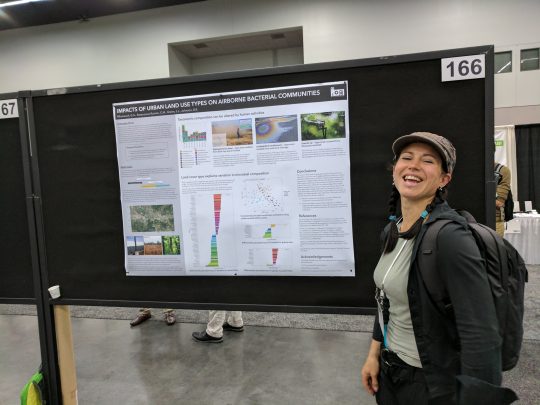The 2017 ESA meeting in Portland, OR, which took place August 6-11, created a flurry of imagination here in Eugene: Roo Vandegrift left with a large hash of approximately 275 live-tweets, Sue Ishaq left with a jumbled pile of hastily scribbled notes in the program book margins, a few of which she has expanded upon, and Ashkaan Fahimipour went away with the inscrutable expression of a mathematical modeler visualizing complex networks in their head. All three presented some of their recent or ongoing work, along with a number of other BioBE members and friends from the UO Institute of Evolution and Ecology.
The meeting started out with a number of engaging science activities, including the Field-to-Collection BioBlitz, which brought conference participants to Forest Park in Portland to collect biological samples for identification and curation. Forest Park is the largest urban forest in the United States, and the biological specimens collected will shed light on the number and types of diversity found there, as well as indicate the success of urban forests at harboring a sustainable level of biodiversity.
The plenary speech was given on Sunday evening, officially opening the conference, and presentations kicked off bright and early on Monday morning. Of the BioBE team, Roo was first to give a presentation on Monday afternoon, on a project led by the recently-defended Dr. Ashley Bateman for her dissertation: Moving Microbes: the dynamics of the skin microbiome in response to environmental exposures. (Revised; listed as “The built environment as a reservoir for transmission and colonization of the skin microbiome.”)
@MycoRoo talking about skin microbiomes #esa2017 pic.twitter.com/Ejotsqj6Rc
— sydney glassman (@sydneyglassman) August 7, 2017
.@iDigBio at #ESA2017 @MycoRoo on Human #microbiome – Mysteries of biome transfer and persistence on human skin. pic.twitter.com/eUcKqipkmK
— Deborah Paul (@idbdeb) August 7, 2017
Erica Hartmann, Assistant Professor at Northwestern University, presented on Tuesday with a compelling talk on the importance of limiting antimicrobial chemicals in synthesized products: Antibiotic resistance and antimicrobial chemicals in the built environment. Antimicrobial chemicals are pervasive in the built and outdoor environments, much more than we realize, yet we have little knowledge of their long-term effect on microorganisms or how this might feed-back onto human health. The full publication can be found here.
On Tuesday evening, doctoral candidate Gwynne Mhuireach presented her poster on Fine-scale urban vegetation patterns shape airborne microbial community composition.
Wednesday evening, Sue presented some preliminary data on a project she is finishing up from her post-doc: Soil bacterial diversity in response to stress from farming system, climate change, weed diversity, and wheat streak virus (poster). A more detailed description of her previous work can be found here.
Ashkaan gave a presentation on Thursday on The dynamics of food web assembly: Structure, stability, and trophic cascades. The study explored how empty ecosystems acquire new species, how the food web develops over time, and how the trophic niches of those colonists can determine the total diversity of the ecosystem or weather disturbances. The large meeting room was well-attended, despite the low total abundance pictured- ecologists don’t seem to like to sit in the front rows.
Once again,@AshkaanF gives a delightful and dynamic talk on complex network modeling as if it’s NBD. I always enjoy his science stories. pic.twitter.com/CBDW9c5Las
— Sue Ishaq (@DrSueIshaq) August 10, 2017
In between our presentations, we filled our days by attending other talks and posters, networking events, and daydreaming about our own science. We took away valuable perspectives on newly discovered results, considerations for data analysis, or the dynamics of ecological systems, which can be incorporated into our own work to improve how we think about indoor systems and approach problem solving. You never know when a presentation on shower heads, baboons, or dormant amoeba might give you an idea which will change the way you think.
Looking ahead, we are anticipating attending a number of conferences on microbiology, air quality, building health, architecture, and ecology over the next year. Here are a few of the meetings that are already on our calendars:
- NASEM: MoBE 2017: Microbiology of the Built Environment Research and Applications Symposium, October 10-12, 2017, Washington, D.C.
- American Society for Microbiology: Microbe, which includes a new Microbiology in the Built Environment track, June 7-11, 2018, Atlanta, GA
- AIA: Conference on Architecture, June 21-23, 2018, New York City, NY
- Gordon Research Conferences: Microbiology of the Built Environment, July 15-20th, 2018, Biddeford, ME – co-chaired by our very own Jessica Green!
- International Society of Indoor Air Quality and Climate meeting, July 22-27, 2018, Philadelphia, PA
- ESA meeting, August 5-10, 2018, New Orleans, LA
- The American Council for Energy Efficient Economy: Summer Study for Energy Efficiency in Buildings, August 12-17, 2018, Pacific Grove, CA
- The 11th International Mycological Congress, 2018, San Juan, Puerto Rico
